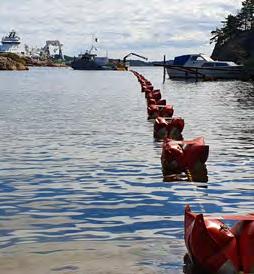
3 minute read
Need for comprehensive protection of the national data centre infrastructure
In recent years, the Norwegian data centre industry has made significant investments. This is a very positive contribution to the goal of strengthening Norway’s position as a data centre nation, thereby facilitating the production of cloud services in Norway.
Data centres are increasingly becoming an integral part of the electronic communications infrastructure – the digital foundation. In addition to electronic communications providers delivering connectivity to and between data centres, the providers’ own services are also increasingly being produced as cloud services in data centres. This applies particularly to 5G mobile services.
The enterprises that are to use cloud services, or who place their own equipment in data centres, are responsible for ensuring their own security. Cloud service providers and data centre operators will then, as ‘subsuppliers’, be subject to the requirements set by customers.
At the same time, data centre operators are not currently subject to comprehensive national security and emergency preparedness regulation. This leaves a risk that the overall national data centre infrastructure, with the accumulated societal values held in the data centres, is not adequately protected in order to meet society’s needs in peacetime and at times of crisis and war.
The Norwegian Government’s new data centre strategy3 provides for assessment of the strengthened regulation of data centre security within the framework of the Norwegian Electronic Communications Act. Nkom considers this to be appropriate. New data centre security requirements must also be balanced against the need for competition, business development and innovation. This is important in order to help to ensure that special security requirements do not create unnecessary entry barriers for cloud services and data centres in Norway.
In its risk assessment for 20214 , NSM points to the extensive prevalence of cloud technology and cloud services. Cloud service providers often deliver more innovative and secure solutions than individual businesses themselves have the capacity and expertise to achieve.
The question is how the security of the services functions in a critical security policy situation. Major cloud service providers are often located abroad. They are based on digital infrastructure that crosses many borders and is vulnerable to sabotage, damage and security policy changes.
3 “Norske datasenter – berekraftige, digitale kraftsenter” (Norwegian data centres – sustainable digital power centres), Norwegian Ministry of Local Government and Modernisation, 2021. 4 “RISIKO 2021 – helhetlig sikring mot sammensatte trusler” (RISK 2021 – holistic protection from complex threats), Norwegian National Security Authority, 2021.
Measures

In accordance with a new data centre strategy, Nkom will contribute to assessing more detailed regulation of data centre security in the electronic communications regulations and other relevant regulations.
On using cloud service/data centre providers in their supply chain, electronic communications providers must ensure security and availability throughout the crisis spectrum, from peace to crises and war.
Municipalities and other public and private enterprises should use their commissioning clout to challenge and make requirements of their suppliers of electronic communications services concerning where/how the services are produced, and how security and accessibility are safeguarded, also in extraordinary situations.
Key milestones for the data centre industry in Norway
In 2021 and 2022, five new submarine fibre connections between Norway and abroad will be commissioned . These are Altibox’s “Skagenfiber” (Larvik-Hirtshals), “Englandskabelen” (StavangerNewcastle), Bulk’s “Mermaid” (New Jersey, USA – Kristiansand/Esbjerg) and “Havsil” (KristiansandHanstholm). Tampnet has also expanded its submarine fibre network in the North Sea, with a new connection between Egersund and Aberdeen. These connections significantly strengthen the connectivity between Norway and abroad.

Photo: Nkom







